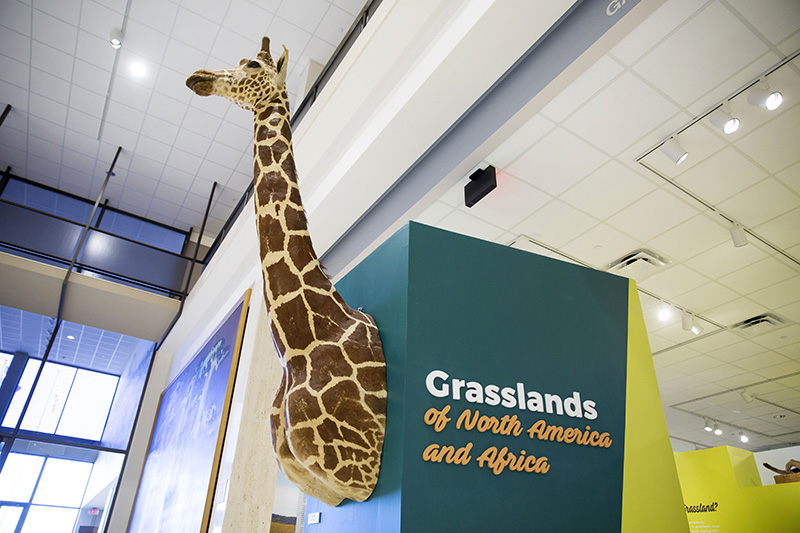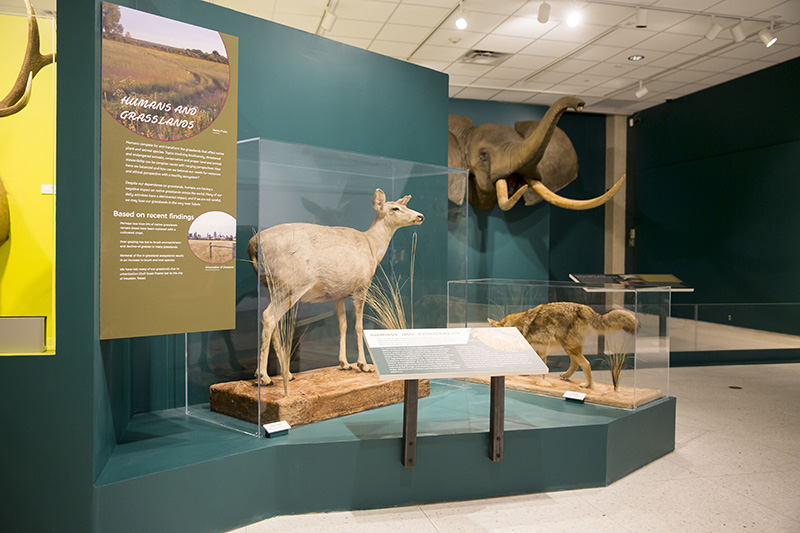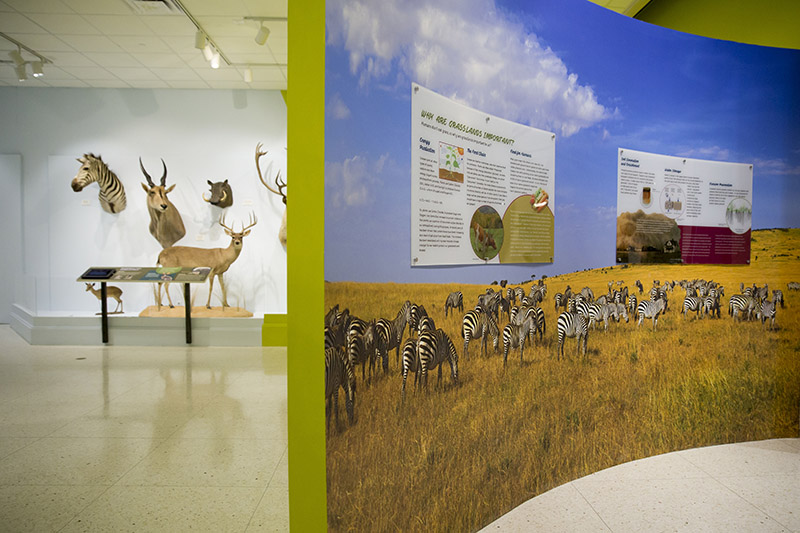Grasslands of North America and Africa
April 2018 – February 2019
Grasslands are a recognizable feature of the biotic landscape, with most of us being
familiar with terms like prairies, savannahs, and maybe even steppes. Grasslands are
 thought to comprise 40 ‒ 70 percent of the world's landmass and are generally defined
based on the percentage of grasses relative to non-grass plants such as sedges, rushes,
forbs, and woody plants such as shrubs, vines, and trees.
thought to comprise 40 ‒ 70 percent of the world's landmass and are generally defined
based on the percentage of grasses relative to non-grass plants such as sedges, rushes,
forbs, and woody plants such as shrubs, vines, and trees.
Typically, the types of grasses present in a grassland are controlled by temperature and rainfall. Most people associate grasslands with grazing animals such as cows, bison, wildebeest, gazelles and zebras, but grasslands are important in a variety of other ways.
In an exhibit at the Museum of Texas Tech University, funded by the Helen Jones Foundation,
we explore the various roles of the world's grasslands. In particular, we compare
the number of mammalian species occurring in North American grasslands,  including the region around Lubbock, to those found in the famous African grasslands
that we see on television and read about in books. Specifically, we focus on different
types of grasslands, how they are classified, what are the important characteristics
and attributes of grasslands, and what steps we can take to preserve them.
including the region around Lubbock, to those found in the famous African grasslands
that we see on television and read about in books. Specifically, we focus on different
types of grasslands, how they are classified, what are the important characteristics
and attributes of grasslands, and what steps we can take to preserve them.
For this exhibit, we arranged for several of the taxidermy specimens housed in the Museum's Natural Science Research Laboratory (NSRL) to be placed on public display. The NSRL contains one the largest research collections of mammal specimens at a North American university—the collection includes skins, skeletons, and tissue samples from more than 130,000 specimens, as well as taxidermy specimens. These taxidermy specimens, most of which are decades old, were donated to the NSRL by hunters and their families for research and education purposes.
Although many of the specimens displayed here represent species that currently are threatened or endangered and now protected by law, none of the specimens in the NSRL collections were hunted or collected from the wild while the species had protected status.
Throughout the exhibit, we use the taxidermy specimens, photographs, and videos to
illustrate the kinds of mammalian biodiversity present in grasslands and to introduce
the visitor to the different categories of animals—carnivores, herbivores and granivores.
We also provide interesting tidbits surrounding the biology and natural history of
these  organisms. Further, we use the exhibit to explore topics such as: why does Africa
have many more species of bovids than North America, what is resource partitioning,
what was the Pleistocene megafauna, what was the impact of ice ages on grasslands,
and what are the differences between true horns, antlers, pronghorns, ossicones, and
rhino horns? Finally, topics that have the potential to have a major interest to the
Lubbock community such as dustbowls, biodiversity in a monoculture agricultural system
verses biodiversity in a grassland, the role of hunting, and the official Texas bison
herd, are presented in order for our visitors to learn more about our local grasslands
and what they can do to help preserve and promote grassland conservation.
organisms. Further, we use the exhibit to explore topics such as: why does Africa
have many more species of bovids than North America, what is resource partitioning,
what was the Pleistocene megafauna, what was the impact of ice ages on grasslands,
and what are the differences between true horns, antlers, pronghorns, ossicones, and
rhino horns? Finally, topics that have the potential to have a major interest to the
Lubbock community such as dustbowls, biodiversity in a monoculture agricultural system
verses biodiversity in a grassland, the role of hunting, and the official Texas bison
herd, are presented in order for our visitors to learn more about our local grasslands
and what they can do to help preserve and promote grassland conservation.
The exhibition will be open through January 2019.
Museum at Texas Tech University
-
Address
3301 4th Street, Lubbock, TX 79415 -
Phone
806.742.2490 -
Email
museum.texastech@ttu.edu
